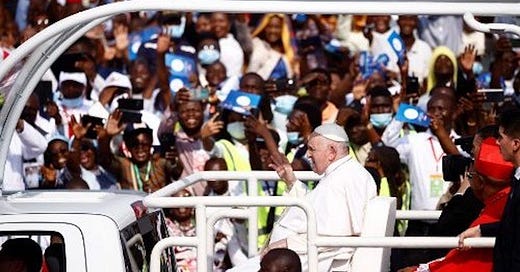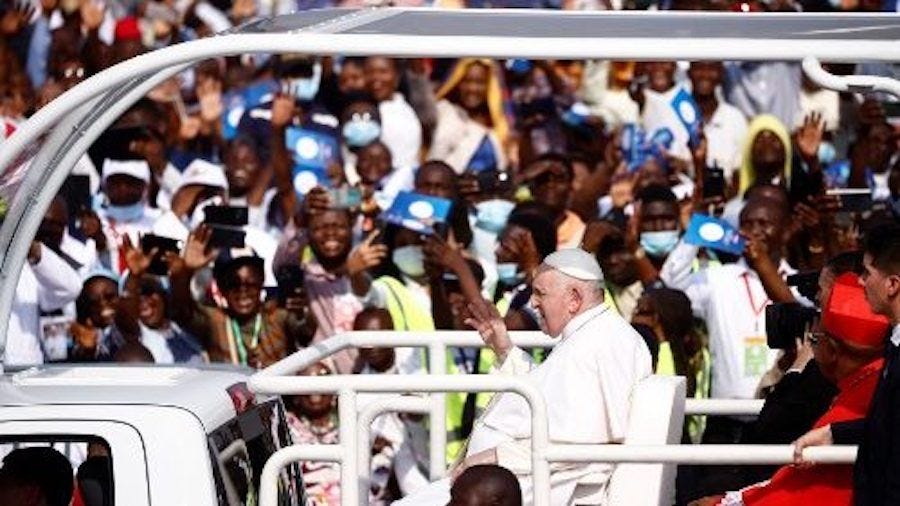
The Church in Africa, by the numbers
Pope Francis is visiting Africa, where countries across the continent have an extremely high rate of Mass attendance and vocations. A look at the numbers.
When Pope Francis flew from Italy to the Democratic Republic of Congo on Tuesday, the pope departed from world’s fifth-largest Catholic country, and landed in the sixth largest.
Long seen as mission territory, Africa is rapidly becoming the center of gravity of global Catholicism. Some might describe the visit by the Church’s first Latin American pope to the African continent as a symbol of the Church’s present, traveling from the region of its past to the region of its future.
The Pillar gives you a look at the numbers.
Among the largest Catholic countries
Seen as the center of the Catholic Church for much of the second millennium, Europe is no longer the home to the world’s largest Catholic populations. Italy has the largest number of baptized Catholics of any European country, and it ranks fifth in the world after Brazil, Mexico, the Philippines, and the United States. Next after Italy is the Democratic Republic of Congo, where Pope Francis is today.
Also among the top 15 countries by Catholic population is Nigeria, despite only 15% of its population being Catholic. And if the list of most Catholic countries were to expand the list by five more, three more African nations would make the list: Uganda, Tanzania, and Angola.
Read more: 'Demography reigns down in Africa'
A quick look at the host countries
The Democratic Republic of Congo is the fourth largest country in Africa in terms of population, and at 55% Catholic (according to data from the World Christian Database) it is one of the continent’s most Catholic countries. Most other residents of the DRC are Protestant, with believers in Islam and other religions making up less than 5% of the population. However, survey data for the DRC can be challenging to collect because of violence and political instability.
After achieving independence from Belgium in 1960, the region was riven by rival political and military factions. President Mobutu imposed a dictatorship on the country from 1965 to 1997, during much of which time the country was called Zaire. Mobutu was overthrown in the First Congo War in 1997. However, a Second Congo War followed from 1998 to 2003, leading to the deaths of 5.4 million people through war and war-induced starvation.
Political stability has increased in the country since 2003, and elections in 2018 saw the country’s first peaceful transfer of power. But political instability remains a concern and many hope that Pope Francis can help to inspire both peace and increased justice and economic reforms.
To the northeast of the DRC, South Sudan is a much smaller country (about 11 million people) and is slightly less Catholic at 51% of the population. About 16% of the population is Protestant, while 33% follow indigenous animist religions and another 6% are Muslim.
South Sudan became an independent country after a referendum in 2011 after a history of ethnic and religious conflict between the region and the rest of Sudan, which is ethnically more Arab and religiously much more Muslim.
In both countries the Church has served as a source of peacemaking and hope in the midst of conflict, but there are distinct differences as well. Filipe D’Avillez provides in depth coverage along with interviews with local Catholic leaders in his piece earlier this week.
The world’s most churched region
In the days before Pope Francis’s visit to the DRC and South Sudan, the Center for Applied Research in the Apostolate (CARA) at Georgetown University published a post on their site looking at Mass attendance in different Catholic countries.
Using data from the World Values Survey, the post reported how many Catholic attend Mass on at least a weekly basis. The very highest rate in the world was for Nigeria, where 94% of Catholics reported going to Mass at least once a week. The next highest rate was for Kenya where 73% of Catholics said they went to Mass at least weekly. The world’s most populous Catholic country, Brazil, fell at the bottom of the list, with only eight percent of Brazilian Catholic saying they went to Mass on at least a weekly basis.
It is difficult to conduct surveys in areas with high political instability and poverty, and that the World Values Survey did not reach many nations in Africa. There is only data available on Mass attendance for Nigeria and Kenya, though both countries - which are situated on opposite coasts of the continent - occupy the highest two slots in the rankings.
But if an analysis assumes that the Democratic Republic of Congo has a Mass attendance rate between Nigeria’s and Kenya’s, the DRC would have the third highest number of Mass-going Catholics in the world, behind only Mexico and the Philippines. Using that assumption about the DRC, the fourth largest Catholic country in terms of Mass-goers would be Nigeria, followed by Colombia in fifth place.
*DRC Mass-attendance rates are estimates.
A global center of vocations
In the past decade, Africa has overtaken Europe as the largest source of priestly ordinations in the world. In 2019 there were 1600 diocesan priests ordained in Africa compared to only 1306 in Europe.
The DRC was responsible for 133 of those 1600 priestly ordinations, second to Nigeria, which ordained a staggering 410 priests that year.
In 2019, the DRC ordained more priests than any European country except Italy (317) and Poland (298).
No European country ordained more priests than Nigeria. The only two countries in the world which ordained more priests in 2019 than Nigeria were the United States and India, both of which ordained 415, just five more than Nigeria.
Even as they struggle with issues of poverty and political instability, countries across Africa see an extremely high level of Mass attendance and vocations. It may take time for numbers relating to Church leadership to catch up to the number of Mass-goers and ordinations.
As of January 2023, Europe has 3.4 times as many voting cardinals as Africa, even while it ordains fewer priests, and sees fewer Catholics at Mass each week. But if the numbers continue as they are now, surely that will shift in the coming years.
Africa is becoming, even more so than in the days of St. Clement of Alexandria and St. Augustine of Hippo, the center of gravity of the Church.



